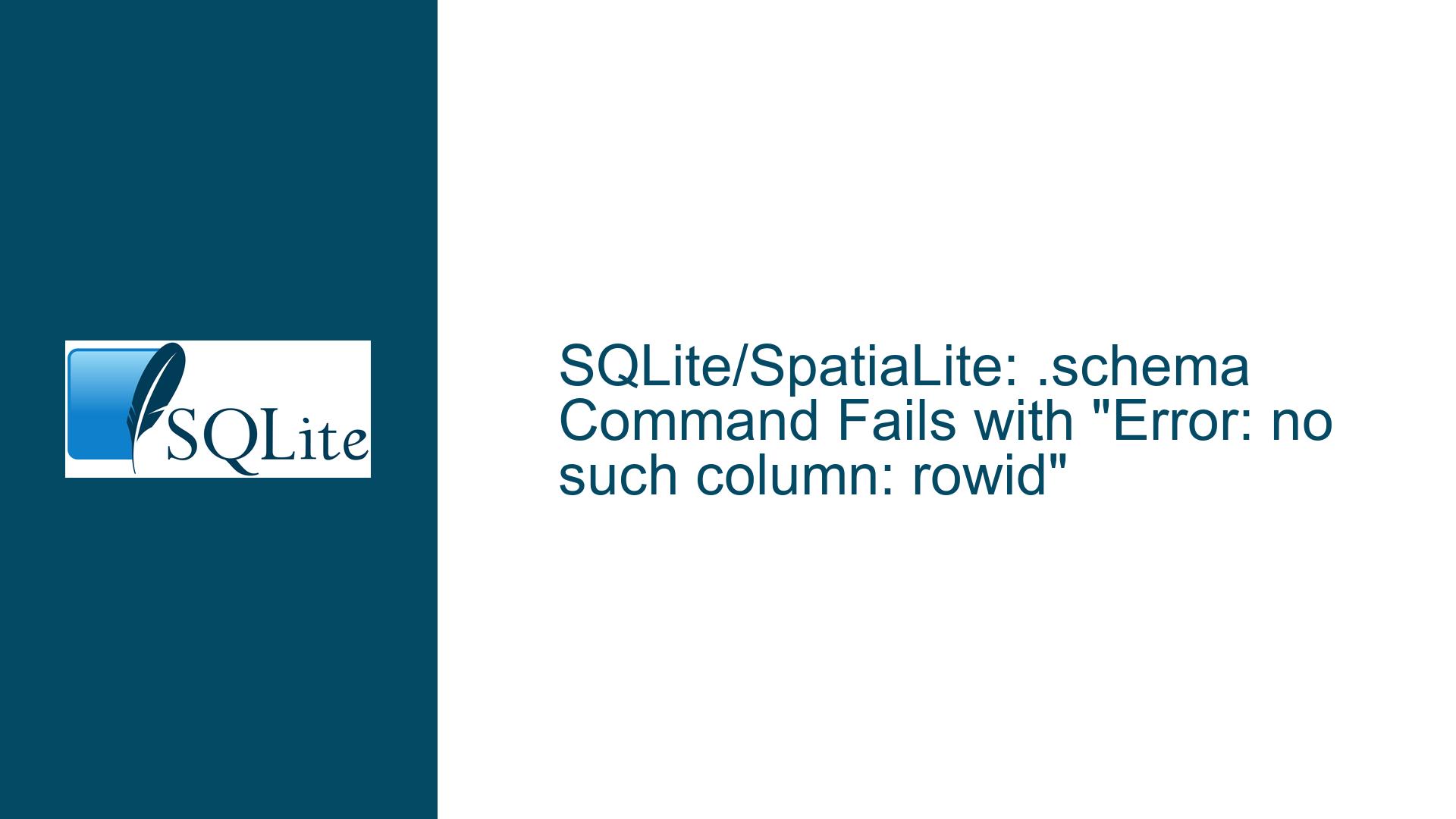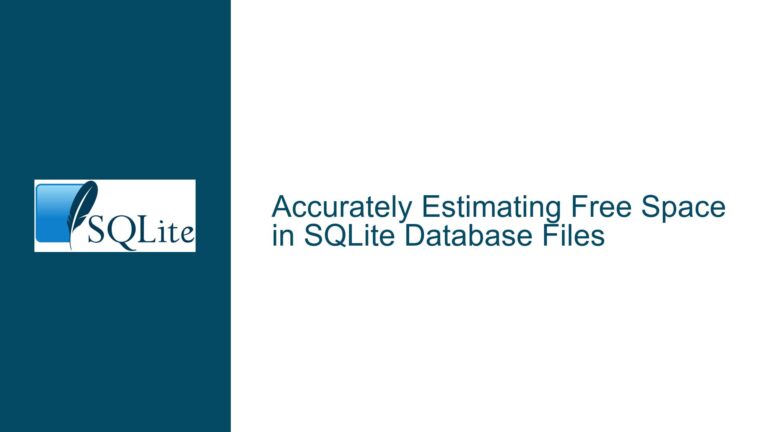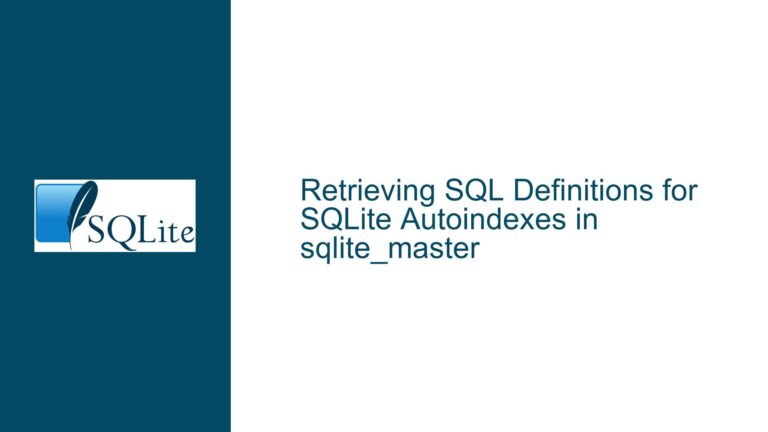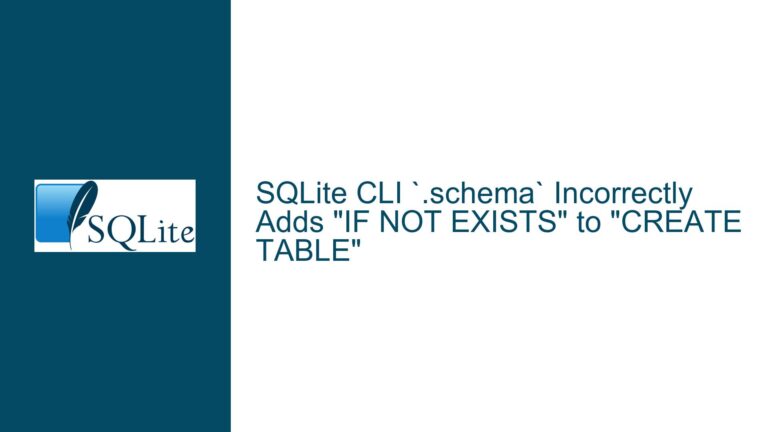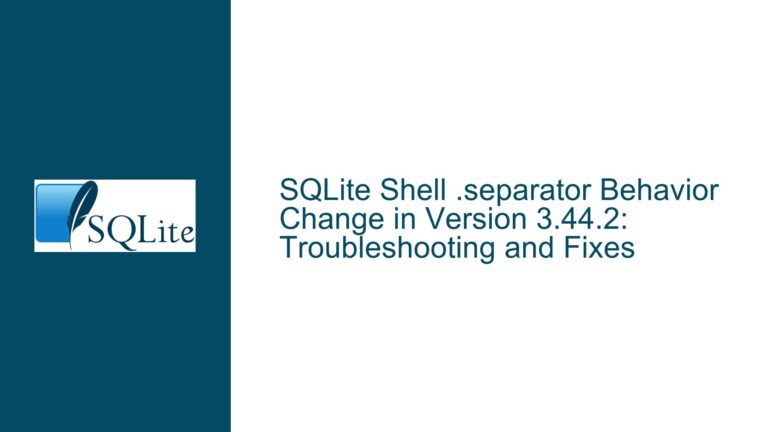SQLite/SpatiaLite: .schema Command Fails with “Error: no such column: rowid”
Understanding the .schema Command and Its Dependencies
The .schema command in SQLite is a powerful utility used to display the schema of a table or the entire database. It retrieves the CREATE TABLE and CREATE INDEX statements that define the structure of the database objects. However, when executing .schema <table>, the error "Error: no such column: rowid" suggests a fundamental issue with how the table is structured or how the command is being interpreted.
The rowid is an implicit column in SQLite tables that acts as a unique identifier for each row. It is automatically created unless the table explicitly defines a column with INTEGER PRIMARY KEY, in which case that column serves as the alias for rowid. The error indicates that the .schema command is attempting to reference the rowid column, but it cannot find it, which is unusual because rowid is typically always present.
This issue could stem from several factors, including database corruption, version mismatches between SQLite and SpatiaLite, or improper table definitions. Understanding the root cause requires a deep dive into the mechanics of SQLite’s schema management and how SpatiaLite interacts with it.
Investigating Database Corruption and Version Mismatches
One of the primary causes of the "no such column: rowid" error is database corruption. SQLite databases are generally robust, but they are not immune to corruption, especially if the database file is accessed concurrently by multiple processes or if the system crashes during a write operation. Corruption can manifest in various ways, including missing or inaccessible columns, which could explain why the .schema command fails to recognize the rowid.
Another potential cause is a version mismatch between SQLite and SpatiaLite. SpatiaLite is an extension to SQLite that adds spatial data capabilities, and it relies on specific SQLite features and behaviors. If the versions of SQLite and SpatiaLite are incompatible, certain operations may fail unexpectedly. For example, if SpatiaLite expects a feature or behavior that is not present in the installed version of SQLite, it could lead to errors like the one observed.
To diagnose these issues, it is essential to verify the integrity of the database and ensure that the versions of SQLite and SpatiaLite are compatible. Running the PRAGMA integrity_check; command can help identify database corruption, while checking the versions of SQLite and SpatiaLite can reveal potential mismatches.
Resolving the Issue: Database Integrity Checks and Version Alignment
The first step in resolving the "no such column: rowid" error is to perform a thorough integrity check of the database. This can be done using the PRAGMA integrity_check; command, which scans the database for inconsistencies and reports any issues. If corruption is detected, the database may need to be restored from a backup or repaired using tools like sqlite3‘s .dump and .restore commands.
If the database integrity check passes, the next step is to verify the versions of SQLite and SpatiaLite. The .version command in SQLite can be used to display the version information, which should be compared against the requirements of the installed SpatiaLite extension. If a version mismatch is identified, updating either SQLite or SpatiaLite to a compatible version may resolve the issue.
In cases where the table definition explicitly excludes the rowid column, it may be necessary to modify the table schema to include an INTEGER PRIMARY KEY column. This column will serve as an alias for rowid, ensuring that the .schema command can reference it correctly. For example, modifying the interfaces table to include an INTEGER PRIMARY KEY column would look like this:
CREATE TABLE interfaces (
id INTEGER PRIMARY KEY,
name TEXT COLLATE NOCASE UNIQUE
);
This modification ensures that the id column acts as the rowid, allowing the .schema command to function correctly.
Advanced Troubleshooting: Debugging SpatiaLite-Specific Issues
If the above steps do not resolve the issue, it may be necessary to delve deeper into SpatiaLite-specific behaviors. SpatiaLite extends SQLite with additional functionality, and certain operations may behave differently when SpatiaLite is involved. For example, SpatiaLite may create virtual tables or use custom functions that interact with the rowid in unexpected ways.
To debug SpatiaLite-specific issues, it is helpful to examine the database schema in detail using the sqlite_master table. This table contains the SQL statements used to create all database objects, and inspecting it can reveal any anomalies or inconsistencies. For example, querying the sqlite_master table for the interfaces table would look like this:
SELECT sql FROM sqlite_master WHERE name = 'interfaces';
This query returns the CREATE TABLE statement for the interfaces table, which can be examined for any unusual or unexpected elements. If SpatiaLite-specific features are identified, consulting the SpatiaLite documentation or seeking assistance from the SpatiaLite community may be necessary.
Conclusion: Ensuring Robust Database Operations
The "no such column: rowid" error when using the .schema command in SQLite or SpatiaLite is a complex issue that can arise from various causes, including database corruption, version mismatches, and improper table definitions. By systematically investigating these potential causes and applying the appropriate fixes, it is possible to resolve the issue and ensure robust database operations.
Performing regular integrity checks, maintaining version compatibility, and carefully defining table schemas are essential best practices for preventing such issues. Additionally, understanding the nuances of SpatiaLite and how it interacts with SQLite can help diagnose and resolve more complex problems. With these strategies in place, database developers can confidently use the .schema command and other SQLite utilities to manage their databases effectively.
